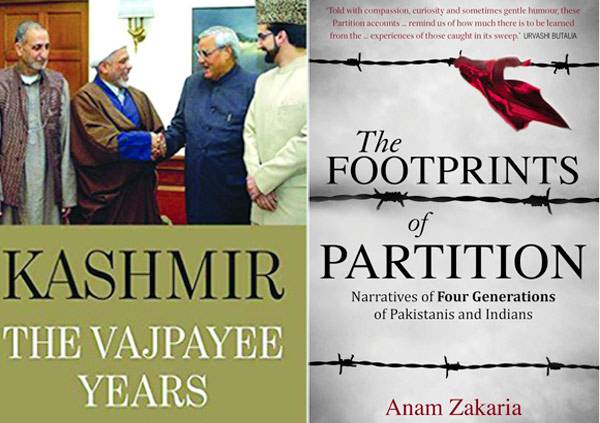
Neither a Hawk Nor a Dove: An Insider’s Account of Pakistan’s Foreign Relations
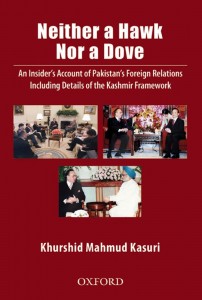
Khurshid Mahmud Kasuri
Oxford University Press [hardback], 2015
PRs 2,450
This book is the first comprehensive account by a Pakistani foreign minister of his direct involvement in moving forward the peace process with India – hailed as the most promising dialogue between Pakistan and India since Independence. Neither a Hawk Nor a Dove provides a detailed analysis of the Kashmir issue and the complex Pakistan–US–Afghanistan–India quadrangular relationship. Khurshid Kasuri believes that, whenever two statesmen are at the helm in India and Pakistan, for relations to improve they will have to revert to the framework formulated during the author’s tenure as foreign minister.
The author speaks frankly about his Indian counterparts, Pranab Mukherjee, Natwar Singh, and Yashwant Sinha, and also about Manmohan Singh and Atal Bihari Vajpayee. He also provides rare insights into the workings of the Pakistan Army, the contributions of the Foreign Office, and his own complex relationship with former President Pervez Musharraf (who, at their first meeting, asked him pointedly, “Are you a hawk or a dove on India, Kasuri sahib?”). Kasuri writes about Pakistan’s important and close relations with China, Saudi Arabia, Turkey, and Iran. On Bangladesh, his comments reflect great nostalgia for old connections.
The narrative is intricately balanced with the author providing interesting anecdotes, both personal and political, alongside his observations on serious issues. Importantly, on foreign policy matters, he deals objectively with those on the other side of the political divide.
Kashmir: The Vajpayee Years
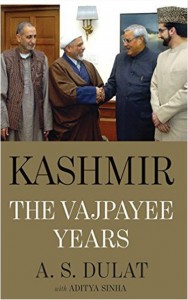
A. S. Dulat with Aditya Sinha
Harper Collins India [hardback], 2015
PRs 1,145
Kashmir was an issue close to former Prime Minister Atal Bihari Vajpayee’s heart. There were repeated setbacks: first, the Kargil war, General Pervez Musharraf’s coup in Pakistan, the hijacking of Indian Airlines flight IC 814 in December 1999 and the Parliament attack two years later. But he countered each with an initiative full of hope: the bus to Lahore in 1999, the Agra Summit in 2001 and, finally, friendly overtures extended to Pakistan in Srinagar in May 2003.
A. S. Dulat, chief of the Research and Analysis Wing under Vajpayee and India’s foremost Kashmir expert, brings nearly two decades of experience in the state to bear on the subject in this book. It looks as much into the future as at the years gone by as it throws light on how a new government can revive and conclude the Vajpayee peace process.
What people are saying: “… a rare glimpse into the working of the Indian state” (Hindustan Times).
The Footprints of Partition: Narratives of Four Generations of Pakistanis and Indians
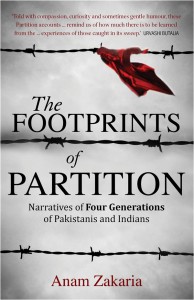
Anam Zakaria
Harper Collins India [paperback], 2015
PRs 695
The Partition of British India and the subsequent creation of two antagonist countries is a phenomenon we are still trying to comprehend. Millions displaced, thousands slaughtered, families divided and redefined, as home became alien land and the unknown became home. So much has been said about it, but there is still no writer, storyteller or poet who has been able to explain the madness of Partition.
Using the oral narratives of four generations of people – mainly Pakistanis, but also some Indians – Anam Zakaria attempts to understand how the perception of Partition and the “other” has evolved over the years. Common sense dictates that the bitter memories of Partition would now be forgotten and new relationships forged over the years, but that is not always the case. The memories of Partition have been repackaged through state narratives, and attitudes have only hardened over the years. Post-Partition events – wars, religious extremism, terrorism – have left new imprints on 1947. This book documents the journey of Partition itself – after Partition.
What people are saying: “Zakaria challenges the notion of predestined animosities between the two hostile states” (Dawn).
Torture and the Twilight of Empire: From Algiers to Baghdad
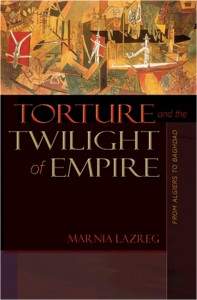
Marnia Lazreg
Princeton University Press [hardback], 2008
PRs 3,600
Torture and the Twilight of Empire looks at the intimate relationship between torture and colonial domination through a close examination of the French army’s coercive tactics during the Algerian war from 1954 to 1962. By tracing the psychological, cultural, and political meanings of torture at the end of the French empire, Marnia Lazreg also sheds new light on the United States and its recourse to torture in Iraq and Afghanistan.
This book is nothing less than an anatomy of torture – its methods, justifications, functions and consequences. Drawing extensively from archives, confessions by former torturers, interviews with former soldiers, and war diaries, as well as writings by Jean-Paul Sartre, Albert Camus and others, Lazreg argues that occupying nations justify their systematic use of torture as a regrettable but necessary means of “saving” Western civilization from those who challenge their rule.
She shows how torture was central to guerre révolutionnaire, a French theory of modern warfare that called for total war against the subject population and which informed a pacification strategy founded on brutal psychological techniques borrowed from totalitarian movements. Lazreg seeks to understand torture’s impact on the Algerian population – especially women – and also on the French troops who became their torturers. She explores the roles Christianity and Islam played in rationalizing these acts, and the ways in which torture became not only routine, but also even acceptable.
Written by a preeminent historical sociologist, Torture and the Twilight of Empire holds particularly disturbing lessons for us today.
Capital in the Twenty-First Century
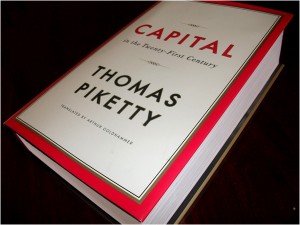
Thomas Piketty
Belknap Press [hardback], 2014
PRs 2,895
What are the grand dynamics that drive the accumulation and distribution of capital? Questions about the long-term evolution of inequality, the concentration of wealth, and the prospects for economic growth lie at the heart of political economy. But satisfactory answers have been hard to find for lack of adequate data and clear guiding theories. In Capital in the Twenty-First Century, Thomas Piketty analyses a unique collection of data from twenty countries, ranging as far back as the eighteenth century, to uncover key economic and social patterns. His findings will transform debate and set the agenda for the next generation of thought about wealth and inequality.
Piketty shows that modern economic growth and the diffusion of knowledge have allowed us to avoid inequalities on the apocalyptic scale predicted by Karl Marx. But we have not modified the deep structures of capital and inequality as much as we thought in the optimistic decades following World War II. The main driver of inequality – the tendency of returns on capital to exceed the rate of economic growth – today threatens to generate extreme inequalities that stir discontent and undermine democratic values. But economic trends are not acts of God. Political action has curbed dangerous inequalities in the past, Piketty says, and may do so again.
A work of extraordinary ambition, originality, and rigor, Capital in the Twenty-First Century reorients our understanding of economic history and confronts us with sobering lessons for today.

